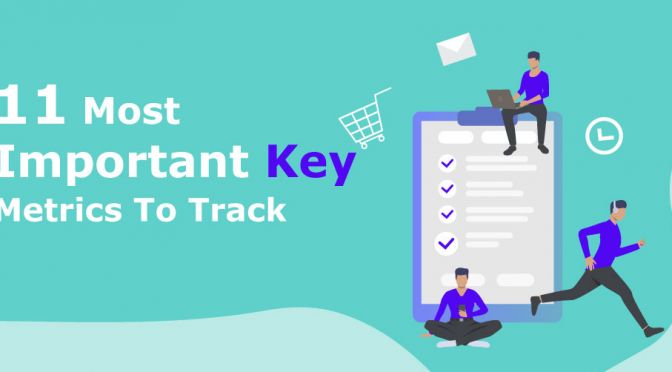The desire to know the different ecommerce key metrics isn’t enough. To fully take advantage of your data, you must have a firm understanding of which sales metrics to use and when.
Sales report that are based on key metrics data is important in increasing or maintaining a high performance sales team? They play a vital role in pointing out exactly what things are needed to change or improved and with which particular aspect of the sales process.
For example, if you set a 20% target in increase total monthly revenue from new prospects but only arrived at say, 5%. You have the sales report to thank for. Sales reports allow you to detect if your prospecting strategy in place is effective or not. You can then device plans for training on prospecting and perhaps spending more on marketing and SEO.
The following are 11 Key Metrics You Need To Track In Your Sales Report
#1 Key Metric: Total Sales.
Your Ecommerce flatform must be able to at the very least offer data on this key metric. All businesses relies on information of the total sales for a particular period, like, daily, weekly, month, etc.. This is the minimum that you need to have access to and that you need to track for your business.
#2 Key Metric: Total Completed Orders
The percentage of orders that your warehouse delivers without incident.
This measurement tells you how often the correct order is sent to the correct customer and is on time and in good condition. If your perfect order rate is low, it’s time to identify the issues and review best practices to ensure that your customers are receiving the products they want, when they were promised.
#3 Key Metric: Average Order Value
Your average order value (AOV) is the average order value per person for a particular period. It is calculated by dividing the (total revenue for a period) by the total number of orders for that period.
This key metric is important in determining how to raise the value of order per person. Cross-selling and up-selling are easily two of the often used sales strategy to address this metric.
#4. Lifetime Value of the Customer
CLV is the total worth to a business of a customer over the whole period of their relationship. It’s an important metric as we have seen this post Double Your Sales with Customer Loyalty Programs ,that it costs less to keep existing customers than it does to acquire new ones, so increasing the value of your existing customers is a great way to drive growth.
How Do You Measure CLV?
If a customer bought a $40 Christmas tree from the same grower for the last 10 years, his CLV has been worth $400 to them. Not factoring the cost for acquiring and maintaining that customer.
CLV is one of the most important key metrics to have for your ecommerce.
#5 Key Metric: Conversion by traffic source
Knowing what source of traffic brings you most sales conversions is huge in today’s online economy. Traffic coming from google, bing, reddit, pinterest, twitter, instagram, etc are just some of the sources of your revenue. But to be given information that tells you which ones of these gives your website the most revenue is big for you decision making.
You can basically streamline your marketing strategy and double your revenue with those data.
#6 Key Metric: Conversion by device type
Over 1.2 billion people worldwide access the internet from their smartphones. That’s four times the population of the US.
90% of consumers say they use multiple devices to complete everyday tasks, while 40% say they use their mobile device to conduct research prior to making a purchase.
The future of mobile commerce is blindingly bright. By 2021, mobile is predicted to dominate online sales, driving 54% (or $659 billion) in sales.
#7 Key Metric. Orders Conversion rate
Conversion rate is calculated by dividing the number of completed orders by the number of website visitors.
Example:
If the number of completed orders is 50, and the number of visitors is 1000. The Orders conversion rate = 5%.
#8 Key Metrics: Orders Conversion rate of new vs returning visitors
Numerous studies have shown that websites tend to have more new visitors and fewer returning visitors. But the returning visitors tend to have higher engagement — they bounce less, view more pages per session, and have higher session durations. They also tend to have higher conversion rates and higher sales…much higher. How higher? It’s 60%-40% in favor of returning visitors. This tells us to sell more to returning visitors.
#9 Key Metric: Percentage of Returning Customers
Returning customers metric is a great metric to track for measuring customer loyalty, but it helps to know how those returning visits translate to revenue. That’s why you should track your percentage of returning customers – the people who come specifically to spend money.
#10 Key Metric: Conversion by Product
The overall conversion rate for your store is an important metric for measuring and improving performance. It’s usually pretty easy to get, depending on your platform. But when working to grow your business, it pays to get granular, especially when it comes to optimizing your products. I always recommend that you know how a specific product is converting before you start optimizing it for pricing, description, SEO keyword phrases, etc.
Conversion by Product rate = (Total purchases for product/Total visits on a website) * 100Example:(2 purchases / 40 visits) * 100 = a 5% Rate of product conversion rate
For e-commerce stores with a huge SKU inventory though, this is a necessary metric to pay attention to.
#11 Key Metric: Cart Abandonment
According to annexcloud, the percentage of abandoned carts ranges anywhere from 50% to 80%.
Cart abandonment is fairly common metric that’s tracked by online stores. E-commerce platforms are even designed to help you keep up on cart abandonment with built in autoresponders to help win back abandoned carts.
In Conclusion:
The most successful eCommerce businesses make decisions based on key metrics. These statistics are significant way to measure your or your team’s confidence in the strategy you put in place. It’s a way to determine if your metrics are reliable. This way, you can decide if there’s really a relationship between your decisions and your results.
Additional resources on analytics and key metrics
How Data Analytics Enhances Ecommerce Business Performance
Ecommerce Analytics Presents Huge Advantages For Your Online Biz
What is SMA – Shoptech Media Analytics?










